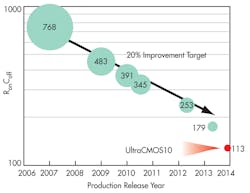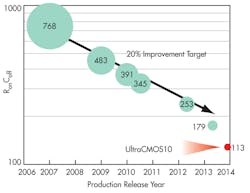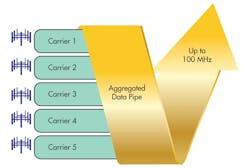Communications Continues To Inspire Technology Advances
This file type includes high resolution graphics and schematics when applicable.
In the microwave and RF arena, semiconductors, communications approaches, and the wireless standards they use are either the focus of research and development or the inspiration behind developments in other areas. Advances in RF semiconductors give designers access to higher frequencies, power, dynamic range, and lower noise parameters, enabling them to design the next generation of RF electronics. Meanwhile, wireless standards provide a roadmap for companies and designers to coordinate their efforts and provide relevant technologies that are compatible with a changing and expanding infrastructure.
Related Articles
• Adapters And Couplers Ride The Millimeter Wave
• Maintaining Security For The Internet Of Things
• Microwave Technology Extends Satellite Precipitation Coverage
Evolving communication techniques allow designers to cleverly use the present technology beyond previously thought boundaries, increasing range, throughput, and signal-to-noise ratio (SNR). By focusing on new innovations and developments surrounding these pillars of the RF/microwave industry, it is possible to gain insight into what the industry’s landscape will look like in the next few years.
RF semiconductor research has recently explored new materials like graphene, carbon nanotubes, metamaterials, superconductors, and even textiles. New methods of stacking ICs, known as 3D ICs, also are a hot topic of research. These avenues may lead to advances in a few years. But they aren’t yet ready to help extend the present capabilities of RF components to the next level in current markets. A few companies, such as Peregrine Semiconductor, are using proven technologies with small leaps in development to provide roadmapped improvements that will be available for next-generation parts.
Peregrine’s silicon-on-insulator (SOI) UltraCMOS 10 is such a process. Peregrine claims it improves 20% consistently every year and is able to support LTE-Advanced (LTE-A) operational requirements (Fig. 1). In many markets, it is thought to have the potential to outpace gallium arsenide (GaAs) as the semiconductor of choice. As noted by Duncan Pilgrim, director of strategic marketing, “When silicon matches GaAs in a market, it takes over.”
The UltraCMOS 10 technology boasts a high-resistance substrate, which allows RF device speeds while incorporating analog and digital blocks on the same substrate. The ability to combine these three regimes lowers costs, increases speeds, and allows for higher yields with advanced integration. To implement the improvements to the UltraCMOS line of products, Peregrine partnered with Siotec and GLOBALFOUNDRIES to create the 130-nm UltraCMOS 10 process and help accelerate process-node reduction.
Good electrostatic-discharge (ESD) performance of 2000 V and potentially higher on every pin is another benefit of UltraCMOS over comparable GaAs technologies. Peregrine is currently testing power amplifiers (PAs) with performance specifications that could be comparable to GaAs PAs and even exceed them, as SOI-based RF components do not degrade linearity as a function of power. The development of SOI PAs along with tuners and switches could open the doors for a complete SOI RF front end, allowing for a complete solution in a single technology. Testing also is being done on devices that, in the next few years, could reach speeds to 50 GHz using SOI technology. The next generation of wireless standards is a driving force for RF semiconductor technologies to enhance the capability of RF switches/tuners while lowering the cost of components. Long Term Evolution Advanced (LTE-A), for example, pushes the boundaries of RF semiconductors by allowing bandwidths to 100 MHz and multiple-input multiple-output (MIMO) operation.
Developed by the 3rd Generation Partnership Project (3GPP), LTE-A is designed to meet or exceed the requirements of the International Telecommunication Union (ITU) for the fourth generation (4G) of radio communication—a standard known as IMT-Advanced. Starting with Release 10 and including later releases, LTE-A is described with higher capacity and increased data rates up to 3 Gb/s for downlink (DL) and 1.5 Gb/s for uplink (UL). Improved performance for cell edges, higher spectral efficiency, and an increase in simultaneous active subscribers also are critical improvements in the Advanced standard over the previous LTE standard. The main new functional additions of the standard include MIMO antenna techniques to 8×8, enhanced uplink, support for relay nodes (RNs), and carrier-aggregation capabilities.
Carrier aggregation offers the ability to use the fragmented bandwidths of a variety of carriers and aggregate them to the 100-MHz maximum bandwidth (Fig. 2). This helps in situations where certain carriers’ bandwidth offerings don’t meet necessary DL or UL requirements for a particular device, but multiple carriers combined could provide adequate data rates. By using an RN as a part of a telecommunications system, signals could be passed from a transmitter potentially much further away or with a much weaker signal to a device that otherwise wouldn’t be able to communicate with adequate signal to noise for high data rates.
There are different types of relays. A Layer 1 relay is merely a repeater that amplifies the signals from transmitter to device while a Layer 2 relay demodulates the signal and modulates/transmits the signal with higher power for noise-reduction purposes. For its part, a Layer 3 relay completely deconstructs/reconstructs the communication signals in the link for higher noise reduction and standards specification benefits. A MIMO antenna system coordinates the frequency capabilities from multiple antennas to allow data rates far greater than a single antenna could accomplish. This multiple-bandwidth operation creates a variety of design difficulties stemming from working with such a large range of RF signals and having to switch and tune the variety of antennas simultaneously. The benefit is that the channels for communication are doubled with each additional antenna that is added to the matrix. As a result, data rates can hit the 3 Gb/s defined by the standard.
This file type includes high resolution graphics and schematics when applicable.
Test Equipment Keeps Pace
This file type includes high resolution graphics and schematics when applicable.
As these standards continue to advance in frequency, bandwidth, and complexity, new and more versatile test and measurement equipment is necessary to characterize and refine the designs of complex communication structures. National Instruments proposes a solution to the complex LTE-A test scenario with its new PXI Express-based vector signal transceiver (VST). This transceiver is a software-programmable combination of a signal analyzer and generator in a PXI package. Agilent Technologies also offers a variety of LTE-A test and measurement solutions in a PXI Express platform.
The evolution toward enhanced standards and resulting increase of RF-component performance is one way to meet the demands of next-generation communications systems. Yet companies like MagnaCom are looking deeper into the root of communication methods to squeeze the most out of already congested communication systems. MagnaCom’s technology, dubbed WAve Modulation (WAM), describes a method of digital modulation that takes a huge advance over the omnipresent quadrature amplitude modulation (QAM) with the same spectral mask. QAM is based on a system of two modulated signals that must operate within the linear region of the RF components with only a two-dimensional (2D) constellation of possible phases for the two signals. In contrast, WAM is designed from the bottom up to assume nonlinearity and multidimensional signal constellations. Because this modulation is purely digital, it does not require any hardware adaptations, is not a compression algorithm, and is a purely backward-compatible replacement of QAM (Fig. 3).
Related Articles
• Adapters And Couplers Ride The Millimeter Wave
• Maintaining Security For The Internet Of Things
• Microwave Technology Extends Satellite Precipitation Coverage
Nonlinearities like white noise, phase intermodulation distortion (PIM), and the nonlinear region of amplifier operation are accounted for automatically with WAM and do not degrade performance, according to Yossi Cohen, CEO of MagnaCom. WAM could allow for PAs and other RF electronics to operate beyond their normal region of linearity, allowing for wider dynamic range from the same hardware. This leads to a proposed benefit of up to 10 dB for the same footprint as a similar QAM4096 system. With higher spectral compression, a WAM system could offer increased signal rates over a QAM system at much lower-order constellation alphabets (64 with WAM compared to 4096 with QAM). WAM also benefits from the same scalability as QAM, increasing in operational performance as the order gets higher in the constellation alphabet.
According to the company, WAM could enable higher system gains, lower power, a boost in range, an increase in throughput, and lower-cost digital designs. The benefit for the designer is that he or she could choose per application. This technique also could provide a solution to the phase-noise issues present at much higher carrier frequencies. MagnaCom is currently looking to apply its technology in point-to-point systems like wireless backhaul, military, and satellite communications.
This file type includes high resolution graphics and schematics when applicable.
About the Author
Jean-Jacques DeLisle
Jean-Jacques graduated from the Rochester Institute of Technology, where he completed his Master of Science in Electrical Engineering. In his studies, Jean-Jacques focused on Control Systems Design, Mixed-Signal IC Design, and RF Design. His research focus was in smart-sensor platform design for RF connector applications for the telecommunications industry. During his research, Jean-Jacques developed a passion for the field of RF/microwaves and expanded his knowledge by doing R&D for the telecommunications industry.




